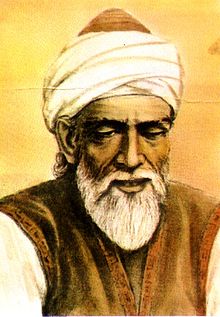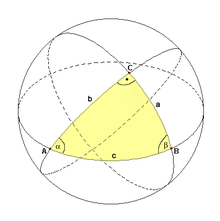Abu l-Wafa
Abu l-Wafa , full name in Arabic أبو الوفا محمد بن محمد بن يحيى بن إسماعيل بن العباس البوزجاني Abu l-Wafa Muhammad ibn Muhammad ibn Yahya ibn Isma'il ibn al-'Abbas al-Buzdschani , DMG Abū l-Wafā Muḥammad bin Muḥammad bin Yaḥyā bin Ismāʿīl bin al-ʿAbbās al-Būzǧānī , (born June 10, 940 in Buzjan , near Nishapur in the eastern Iranian region of Khorasan , died on 15 July 998 in Baghdad ) was a prominent Persian mathematician and astronomer of the middle ages , wrote what several books on Mathematics, several significant trigonometric made discoveries and now lost commentaries on the works written by Euclid , Diophantus of Alexandria and al-Khwarizmi .
biography
Abu'l-Wafa grew at the time of the seizure of power by the Buyids - dynasty (reigned in western Iran and Iraq from 945 to 1,055) and looked to her wedding under the reign of Adud ad-Daula (reigned 949-983.). He was a great patron of the arts and sciences and, in addition to Abu'l-Wafa, drew other outstanding scholars, such as the mathematicians Abu Sahl al-Quhi and al-Sidschzi , to his court in Baghdad.
Al-Wafa also worked in Baghdad under his son, the subsequent Emir Sharaf ad-Daula , and was involved there alongside al-Quhi in the observatory , which was completed in 988 . The instruments included a quadrant more than 6 meters long and a stone sextant over 18 meters long. This made it possible for Abu l-Wafa to determine the inclination of the ecliptic , the length of the seasons and the longitude of Baghdad , along with many other astronomical observations . After Sharaf ad-Daula's death, the observatory was closed again immediately. Al-Wafa also worked with al-Biruni in Khorezmia to determine the difference in longitude between the two locations more precisely from the simultaneous observation of the lunar eclipse on May 24, 997. Contrary to occasional claims, however, he did not discover the irregularities of the lunar orbit .
plant
Abu l-Wafa is known for the first use of the tangent function , and for creating tables for the six trigonometric functions in 15 'intervals (corresponds to a quarter of a degree ). The stated values are accurate to eight decimal places (for comparison: Ptolemy 's values were only exact to three decimal places ). He also introduced the functions of the secan and cosecan and anticipated modern mathematical developments when he proposed defining the trigonometric functions via the unit circle . These elaborations were made by al-Wafa as part of his investigation of the lunar orbit .
In the years after 961, al-Wafa wrote a mathematics textbook for scribes and business people, the Kitāb fī mā yaḥtaǧ ilayhi al-kuttāb waʾl-ʿummāl min ilm al-ḥisāb (“Book about what is necessary to know from the science of arithmetic , for scribes and business people ”). Although al-Wafa was an expert in the use of Indian numerals , he wrote out all the numbers in this book in words, so the calculations must be made in the head. This was still quite common at that time, as the use of Indian numerals , mostly called Arabic numerals today, was not in use for a long time among the group of people addressed .
Al-Wafa wrote another application book for the practitioner after 990, the Kitāb fī mā yaḥtaǧ ilayhi aṣ-ṣāniʿ min al-aʿmāl al-handasiyya ("Book about what is necessary to know about geometric constructions for craftsmen"). It is about the construction of right angles , construction of parabolas and regular polygons, among many other things . Al-Wafa tries to get by with a ruler and (a fixed) pair of compasses . For problems that cannot be solved by construction, such as the three-dimensional division of the angle , which is one of the classic problems of ancient mathematics , he specifies constructions with other aids, such as Neusis constructions and compasses with fixed radius settings. In the construction of the regular heptagon he only gives a (very good) approximate solution.
In another work, the Kitab al-Kamil ( Complete Book ), al-Wafa presents a simplified version of Ptolemy's Almagest , from which many later astronomers took the observation data and used it for their own calculations.
al-Wafa simplified the ancient methods of spherical trigonometry and proved the sine law for general spherical triangles :
In addition, he established various trigonometric identities, such as:
In honor of Abu l-Wafa's astronomical findings, the lunar crater Abul Wáfa was named after him.
literature
- Adolf Pawlowitsch Juschkewitsch : Abū'l-Wafāʾ Al-Būzjānī, Muḥammad Ibn Muḥammad Ibn Yaḥyā Ibn Ismāʿīl Ibn Al-ʿAbbās, Dictionary of Scientific Biography , Online
- ES Kennedy: Applied mathematics in the tenth century: Abu'l-Wafa calculates the distance Baghdad - Mecca, Historia Math., Vol. 11, 1984, pp. 193-206.
- ES Kennedy, M. Mawaldi: Abu al-Wafa 'and the Heron theorems, J. Hist. Arabic Sci., Vol. 3, 1979, pp. 19-30.
- MI Medovoi: On the arithmetic treatise of Abu'l-Wafa, Studies in the history of mathematics, Volume 13, 1960, pp. 253-324.
- AS Saidan: The arithmetic of Abu'l-Wafa ', Isis, Volume 65, 1974, pp. 367-374.
- J. Sesiano: Le traité d'Abu'l-Wafa sur les carrés magiques, Z. Gesch. Arab-Islam. Wiss., Vol. 12, 1998, pp. 121-244.
- H. Suter: The book of geometric constructions by Abu l'Wefa, treatises on the history of natural sciences and medicine, 1922, pp. 94-109
Web links
- John J. O'Connor, Edmund F. Robertson : Abu l-Wafa. In: MacTutor History of Mathematics archive .
- Reza Sarhangi, Slavik Jablan: Elementary Constructions of Persian Mosaics. Towson University and The Mathematical Institute, 2006. PDF (English)
| Abu l-Wafa (alternative names of the lemma) |
|---|
| Abu'l Wafa, Abul Wefa, Abu l-Wāfā ', Muhammad Aboûl-Wafâ, Mohammad Abu'l-Wafa Al-Buzjani, Muhammad ibn Muhammad ibn Yahya ibn Isma'il ibn al-'Abbas Abu'l-Wafa' al -Buzjani or Abu'l-Wafa Mohammed ibn-Mohammed ibn-Yahya ibn-Ismail Buzjani |
| personal data | |
|---|---|
| SURNAME | Abu l-Wafa |
| ALTERNATIVE NAMES | Abu l-Wāfā '; Muhammad Aboûl-Wafâ, Mohammad Abu'l-Wafa Al-Buzjani; Abu'l-Wafa Mohammed ibn-Mohammed ibn-Yahya ibn-Ismail Buzjani; Abul Wefa; Muhammad ibn Muhammad ibn Yahya ibn Isma'il ibn al-'Abbas Abu'l-Wafa 'al-Buzjani |
| BRIEF DESCRIPTION | Persian mathematician |
| DATE OF BIRTH | June 10, 940 |
| PLACE OF BIRTH | Buzjan |
| DATE OF DEATH | July 15, 998 |
| Place of death | Baghdad |





